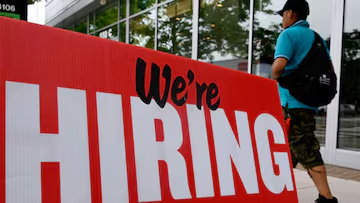How high could unemployment increase in the US in 2023?
The Federal Reserve has updated its economic outlook and projections, which forecast unemployment to rise by at least one percent.


The Federal Reserve’s Federal Open Market Committee has released its quarterly economic outlook and projections, which forecast the median unemployment rate for 2023 to hit 4.5 percent.
The current national unemployment rate sits at 3.6 percent but differs across educational backgrounds, gender, race and ethnicity, ethnicity, and a variety of other demographic groupings.
Employment Rates February 2022 & February 2023: Demographic Breakdown
| February 2022 | Februray 2023 | Change | |
|---|---|---|---|
| Education | |||
| Less than a high school diploma | 4.5% | 5.8% | +28% |
| High school graduates, no college | 4.4% | 3.6% | -18% |
| Some college or associate degree | 3.7% | 3.2% | -13% |
| Bachelor’s degree and higher | 2.2% | 2.0% | -9% |
| Race and ethnicity | |||
| White | 3.3% | 3.2% | -3% |
| Black | 6.6% | 5.7% | -13% |
| Asian | 3.0% | 3.4% | +13% |
| Hispanic and Latino | 4.5% | 5.3% | +17% |
| Gender (20 years and over) | |||
| Men | 3.5% | 3.3% | -5% |
| Women | 3.6 | 3.2% | -11% |
The national unemployment rate blurs distinctions across demographic groups and strips away a lot of important context.
Additionally, the Fed’s projections do not provide insights into how these various groups will be impacted by increases in unemployment spurred by rate hikes. Nobel Prize-winning economist, for those value mainstream credentials Joseph Stiglitz, has warned that young men of color, a group whose unemployment rate is already higher than the national average, could see worklessness rise by anywhere between fifteen to twenty percent given where the Fed has set interest rates.
Read more from AS USA:
- IRS Disallowed Credit: What to do if your claim for EITC is denied
- Which celebrities have been charged by SEC for illegally promoting crypto?
- How does the Fed interest rate hike affect mortgages, student loans and credit cards?
How high will unemployment go?
In 2022, the median unemployment rate was 3.6 percent, and this year the Fed expects this to reach 4.5 percent. This should not be confused with the average rate for the year. The median is the midpoint, meaning that there could be months where the rate surpasses 4.5 percent. The range given by the central bank extends between 3.9 percent to 4.8 percent. What this range indicates is that by the end of the year, the number of people without work could be one percent higher, equating to millions of workers being stripped from the labor force.
Signs that the labor market is softening
There are a few signs that the labor market is softening, which indicates that the impact of rate increases are beginning to be felt across the economy. For much of 2021 and 2022, ‘The Great Resignation’ was a top story after a record-breaking number of workers quit their jobs in search of better pay and conditions. Nearly one hundred million workers voluntarily left their job over the past two years, according to the Bureau of Labor Statistics. However, in January, the level of quits came in under four million for the first time since May 2021. January also saw an uptick in the number of workers who were laid off, 1.7 million, the highest number since early 2020 when the covid-19 pandemic forced millions out of the workforce. Increasing layoffs in February and March would indicate that the demand for labor is falling, which puts workers in a worse position to negotiate pay and benefits with future employers.
The Federal Reserve’s Beige Book, which compiles data from the various Districts that make up the US central bank, reported that employers became “less flexible with employees and beginning to reduce remote work options” towards the end of 2022. Simultaneously with that development came news that wages had slowed their pace of growth and “are expected to moderate further in the coming year.” The BLS reported earlier this month that over the last year, real wages have fallen by 1.3 percent. While businesses may be writing larger checks, on average, workers are not seeing increases in their purchasing power.
Related stories
All of these indicators point towards a softening in the labor market that the Federal Reserve hopes will decrease aggregate demand among consumers and lead to a fall in prices.
Not all agree with the Fed’s move to increase rates even further
In light of all these data points and the recent collapse of Silicon Valley Bank, some political leaders like Senator Elizabeth Warren criticized the Federal Reserve for continuing to increase rates. Senator Warren noted that inflation continues to create a very challenging environment for families but that those same households will not be better off if they lose their jobs as a result of the central bank’s move to implement further rate hikes.
The Fed under Chair Powell made a mistake not pausing its extreme interest rate hikes. I've warned for months that the Fed's current path risks throwing millions of Americans out of work. We have many tools to fight inflation without pushing the economy off a cliff.
— Elizabeth Warren (@SenWarren) March 22, 2023

